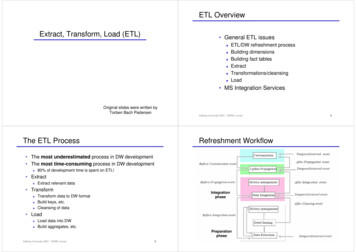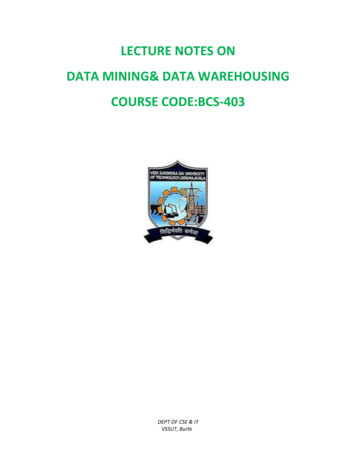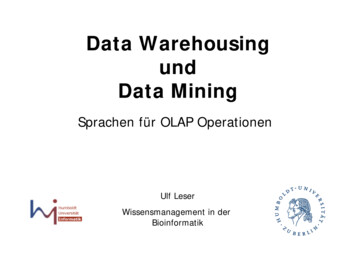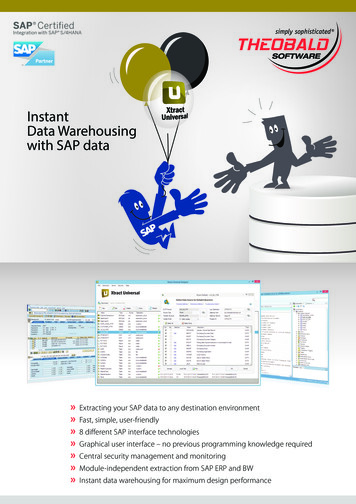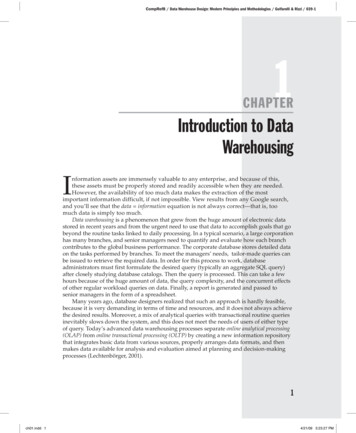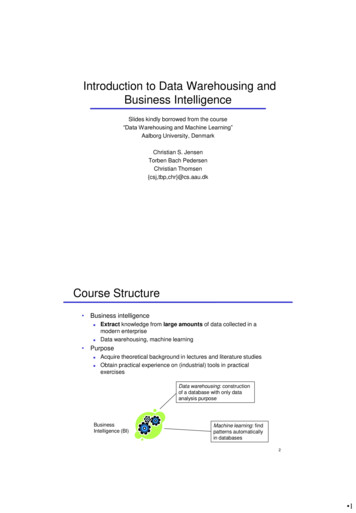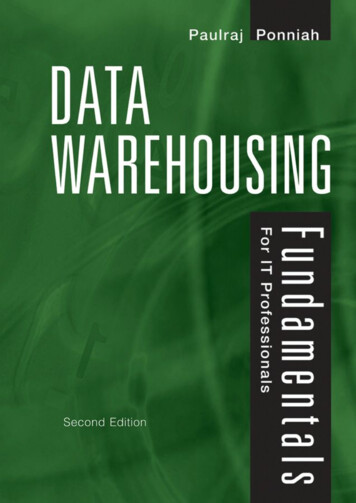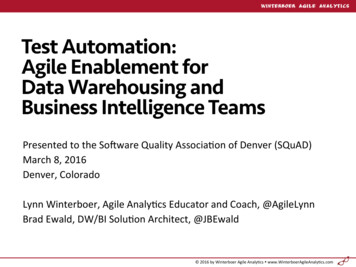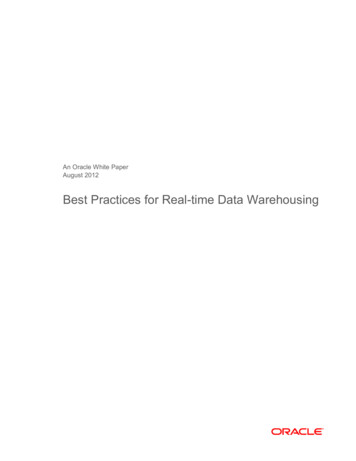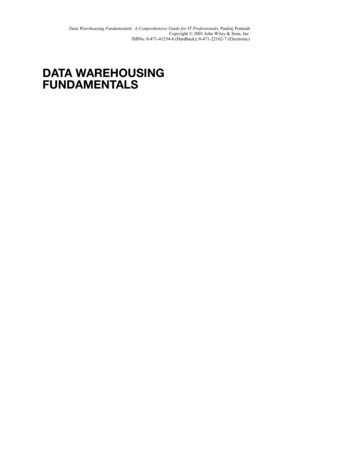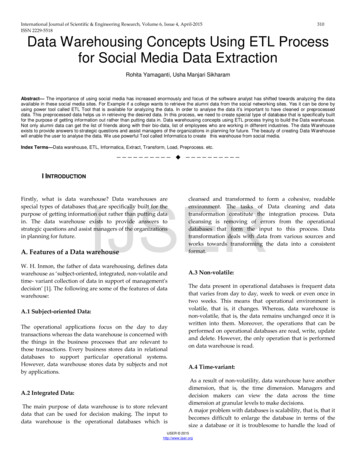
Transcription
International Journal of Scientific & Engineering Research, Volume 6, Issue 4, April-2015ISSN 2229-5518310Data Warehousing Concepts Using ETL Processfor Social Media Data ExtractionRohita Yamaganti, Usha Manjari SikharamAbstract— The importance of using social media has increased enormously and focus of the software analyst has shifted towards analyzing the dataavailable in these social media sites. For Example if a college wants to retrieve the alumni data from the social networking sites. Yes it can be done byusing power tool called ETL Tool that is available for analyzing the data. In order to analyse the data it’s important to have cleaned or preprocesseddata. This preprocessed data helps us in retrieving the desired data. In this process, we need to create special type of database that is specifically builtfor the purpose of getting information out rather than putting data in. Data warehousing concepts using ETL process trying to build the Data warehouse.Not only alumni data can get the list of friends along with their bio-data, list of employees who are working in different industries. The data Warehouseexists to provide answers to strategic questions and assist managers of the organizations in planning for future. The beauty of creating Data Warehousewill enable the user to analyse the data. We use powerful Tool called Informatica to create this warehouse from social media.Index Terms—Data warehouse, ETL, Informatica, Extract, Transform, Load, Preprocess. etc.—————————— ——————————I INTRODUCTIONIJSERFirstly, what is data warehouse? Data warehouses arespecial types of databases that are specifically built for thepurpose of getting information out rather than putting datain. The data warehouse exists to provide answers tostrategic questions and assist managers of the organizationsin planning for future.A. Features of a Data warehouseW. H. Inmon, the father of data warehousing, defines datawarehouse as ‘subject-oriented, integrated, non-volatile andtime- variant collection of data in support of management'sdecision’ [1]. The following are some of the features of datawarehouse:A.1 Subject-oriented Data:The operational applications focus on the day to daytransactions whereas the data warehouse is concerned withthe things in the business processes that are relevant tothose transactions. Every business stores data in relationaldatabases to support particular operational systems.However, data warehouse stores data by subjects and notby applications.A.2 Integrated Data:The main purpose of data warehouse is to store relevantdata that can be used for decision making. The input todata warehouse is the operational databases which iscleansed and transformed to form a cohesive, readableenvironment. The tasks of Data cleaning and datatransformation constitute the integration process. Datacleansing is removing of errors from the operationaldatabases that form the input to this process. Datatransformation deals with data from various sources andworks towards transforming the data into a consistentformat.A.3 Non-volatile:The data present in operational databases is frequent datathat varies from day to day, week to week or even once intwo weeks. This means that operational environment isvolatile, that is, it changes. Whereas, data warehouse isnon-volatile, that is, the data remains unchanged once it iswritten into them. Moreover, the operations that can beperformed on operational databases are read, write, updateand delete. However, the only operation that is performedon data warehouse is read.A.4 Time-variant:As a result of non-volatility, data warehouse have anotherdimension, that is, the time dimension. Managers anddecision makers can view the data across the timedimension at granular levels to make decisions.A major problem with databases is scalability, that is, that itbecomes difficult to enlarge the database in terms of thesize a database or it is troublesome to handle the load ofIJSER 2015http://www.ijser.org
International Journal of Scientific & Engineering Research, Volume 6, Issue 4, April-2015ISSN 2229-5518concurrent users. As a result, companies have vested hugeresources to incorporate data warehouses that can storemillions of records and enable parallel usage by multipleUsers [5]. So, ETL is used widely before storing data intodata warehouse as the main intension is to discoverknowledgeable patterns and trends whilst decision making.In this paper, I will discuss the ETL process in detailsucceeding towards Informatica tool and how it is used toperform ETL.II. BACKGROUNDThe brief insights of Extract, Transform and Load processeswill be discussed in this section along with the Informaticatool. The sections is divided to cover the concepts ofDimension modelling (section A), ETL (section B) followedby introduction to Informatica tool (section B).A. Dimensional ModellingJust the way ER modelling is used to design a database;dimension modelling is required to design the dimensionsthat are nothing but subjects of a data warehouse.Dimension modelling describes the following:1. Subject areas that are involved in building a warehouse.2. The level of detail of data which is termed granularity.3. The time span of database. This is calculated bydetermining how much of archived data needs to be storedin a warehouse [1].Data warehouse models can be built using three differentschemas: Star Schema: Here, the fact table, which consists ofmeasure, and facts, is arranged surrounded bydimensions which resemble a star. Snowflake Schema: This schema is very similar to starschema except that the dimensions are normalized. Fact constellation Schema: This schema is not used as itcontains multiple fact and dimension tables that areshared amongst each other [1].Fact tables can be classified based on the level of data thatis stored: Detailed fact table: This store detail information aboutthe facts. Summarized fact table: This are also called asaggregated fact table as they contain aggregated data.311the files are extracted from various sources, rules areexamined, transformations are applied, and finally the datais cleansed.ETL is generally performed in a separate server calledstaging server. Although, this adds an additional cost andcomplexity to building a data warehouse, it has variousadvantages:1. Security: As the staging area is not accessed by datawarehouse users, it offers security and quality.2. This path helps in sharing load as ‘data preparation’ anddata querying tasks are isolated and handled separately.(II) What is ETL? ETL stands for Extract, Transform andLoad functions that are used by data warehouse topopulate data.Data Extraction is responsible for gathering data fromvarious homogenous, heterogeneous and external sources.Data Transformation uses the data extracted and covertsthis data into warehouse format.Load just fills the target with a collection of data that iscleaned, standardized, and summarized [2], [3].Fig. 1 summarizes the data staging phase while buildingdata warehouse.IJSERB. ETL process(I) why is ETL required? ETL is performed in the datastaging phase of data warehouse. Data staging is anintermediate yet an important task in forming a datawarehouse [1]. It is comparable to a construction site whereC. Informatica InterfaceInformatica is a powerful tool and a widely used ETL toolfor extracting the source data and loading it into target afterapplying the required transformation [4]. It is a successfulETL tool because easy training and tool availability hasmade easy resource availability for software industry;where else other ETL tools are way behind in this aspect.As shown in Fig. 2 [8] the startup page of Informatica hasrepositories listed on the left side which is connected byusername and password. As the repository is connected,folders could be seen. In these folders, various options areavailable namely Sources, Targets, Transformations,Mappings. For performing ETL, the source table shouldhave data while the target table should be empty andshould have same structure as that of source.
International Journal of Scientific & Engineering Research, Volume 6, Issue 4, April-2015ISSN 2229-5518Steps in performing ETL using Informatica:1. Extract: In Informatica, data can be extracted from bothstructured as well as unstructured sources. It can accessdata from the following: Relational Databases tables created in MicrosoftSQL server, Oracle, IBM DB2, and Teradata.Fixed and delimited flat files, COBOL files andXML.Microsoft Access and Excel can also be used.joiner. It also converts the source data types to theInformatica native data types. Union is used to merge data from multiple tables. Itmerges data from multiple sources similar to theUNION ALL SQL statement to combine the results fromtwo or more SQL statements. Router is similar to filter transformation because bothallow you to apply a condition to extracted data. Theonly difference is filter transformation drops the datathat do not meet the condition whereas router has anoption to capture the data that do not meet thecondition.3. Load: After transformation is complete, the final step isto load the targets. There are two types of loads that areavailable in Informatica:I. Normal Load: This type is comparatively slow asit loads the target database record by record. Also,this load writes databases logs so that the targetdatabase can recover from an incomplete session.II. Bulk Load: This load improves the performanceas it inserts large amount of data to targetdatabase. While bulk loading, the database logs arebypassed which increases the performance [9].IJSER2. The source is transformed with the help of variousTransformations like:Expression is used to calculate values in a singlerow. Example: to calculate profit on each productor to replace short forms like TCS to ‘TataConsultancy Services’ or to concatenate first andlast names or to convert date to a string field [7]. Filter keeps the rows that meet the specified filtercondition and purges the rows that do not meet thecondition. For example, to find all the employeeswho are working in TCS. Joiner is used to join data from two relatedheterogeneous sources residing in differentlocations or to join data from the same source.Types of Joins that can be performed include Inner(Normal), Left and Right Outer join (Master Outerand Detail Outer) and Full Outer join. Rank is used to select the rank of data. Example: tofind top five items manufactured by “Johnson &Johnson” Aggregator is used to summarize data with helpof aggregate functions like average, sum, count etc.on multiple rows or groups. Sorter is used sort data either in ascending ordescending order according to a specified sort key. Source Qualifier is used to select values from thesource and to create a conventional query to issuea special SELECT statement. It can also be used as a 312As the target is loaded, let’s have a look on the targettypes: Relational databases like Oracle, Sybase, IBM DB2,Microsoft SQL Server, and Teradata.Fixed and delimited flat file and XML.Microsoft accessIII Case Study:We will show the implementation of using facebook.1.Firstly we have to create facebook app throughhttps://developers.facebook.com/1.facebook account
International Journal of Scientific & Engineering Research, Volume 6, Issue 4, April-2015ISSN 2229-55183136. App id is consumer id and app secret is consumersecret. Click on show to create App Secret.2.3.4.Create an applicationGo to my app - add a new appSelect wwwNext click the option (skip and create a app ID)IJSER7.8.9.Next go to settingsNext enter the email and save the changes.Open Informatica OAuth Utility using a URL: domainname: informatica port number/ows/10. Enter the consumer key and secret.5.Next fill the details11. Copy the default callback URL .and go to yourcreated facebook application.12. Click Add Platform.
International Journal of Scientific & Engineering Research, Volume 6, Issue 4, April-2015ISSN 2229-551831420. Next go to OAuth and fill the required details13.14.15.16.Select website. And paste the OAuth callback URLAnd enter the mobile site URL.Click save changesNext go to status and review.IJSER21. Click Authorize.17. Select yes to make your app in live mode22. Click Okay.23. We have successfully connected informatica tosocial media.18. Click confirm.19. Now the application is in live mode.
International Journal of Scientific & Engineering Research, Volume 6, Issue 4, April-2015ISSN 2229-551824. Close the window.25. Next go to Informatica developer.26. Create a new project.31. Fill the details click next button27. Next right click to project Name next select newand next select Data Object.IJSER28. Next select facebook data object.29. Next connections click browse button and selectfacebook next click more option.32. Enter app id & secret and next click.30. Double click Domain and select social media facebook next click add button.33. Next OAuth Access key copy and paste thiswindow.34. Next click test connection. And click finish.315
International Journal of Scientific & Engineering Research, Volume 6, Issue 4, April-2015ISSN 2229-5518316IV. CONCLUSIONData ware housing concepts along with the ETL processesare covered in depth in this paper. This paper gave aninsight to the various aspects and steps in the ETL tools andalso explains the user friendly nature of the tool.Asdiscussed in the paper, the advantages of using Informaticaare many fold. Informatica is very user friendly as itbecomes easy to understand and use. Also, Informatica hasits capability of enabling Lean Integration so that noresource is wasted during the process. We haveimplemented the complete steps in the Informatica; theresults (screen shots) are attached to this paper. The paperwill surely help in understanding the ETL tool and helpsthe researcher to create their own data warehouse.IJSERACKNOWLEDGMENTWe would like to acknowledge the department ofComputer Science and Engineering of Sreenidhi Institute ofScience an
Data Warehousing Concepts Using ETL Process for Social Media Data Extraction Rohita Yamaganti, Usha Manjari Sikharam . Abstract— The importance of using social media has increased enormously and focus of the software analyst has shifted towards analyzinghe data t available in these social media sites. For Example if a college wants to retrieve the alumni data from the social networking sites .
